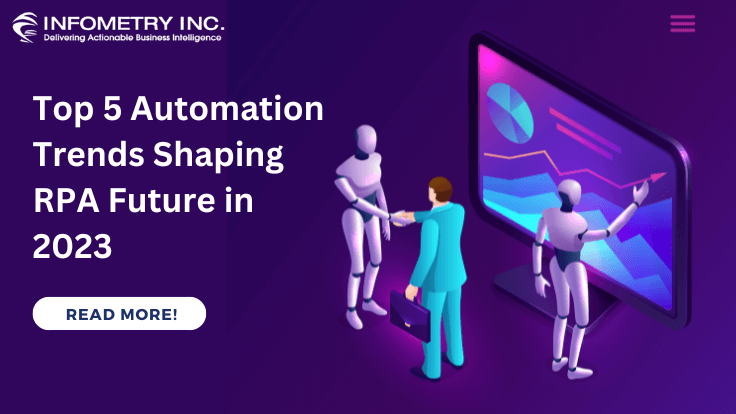
Top 10 Effective Data Visualization Best Practices
February 9, 2023
Top 5 Automation Trends Shaping RPA Future in 2023
February 16, 2023Hyperautomation and Its Process
Hyperautomation is an evolving approach to automation, but Gartner has already recognized it as one of the top 10 tactical technology trends. They conducted a new survey which presented that 85% of contributors would ‘either increase or sustain their enterprises’ hyperautomation investments over the next 12 months, and over 56% already have four or more concurrent hyperautomation initiatives.
It is like wise significant to note that the pandemic’s role in the adoption and acceleration of hyperautomation within the market powering the prioritization of digital transformation and automation initiatives over the last year. The distributed business ecosystem eases the burden that repetitive processes and legacy infrastructure incur on companies and their resources. The transformation that it affords an organization enables it to operate more streamlined, often resulting in reduced costs and a stronger competitive position.
Legacy processes and infrastructure can slow an organization down and affect its ability to be competitive. It transforms an organization by automating as many processes and tasks as possible.
Defining Hyperautomation
Hyperautomation is a technology-driven approach to automating processes in an organization that combines multiple tools, including machine learning (ML), artificial intelligence (AI), and robotic process automation (RPA), to deliver end-to-end automation. The goal of hyperautomation is to automate as much as possible, taking into account technical, operational, and business considerations. It aims to create a sophisticated, integrated system of automation that spans the entire enterprise and goes beyond traditional automation to achieve significant efficiency, effectiveness, and agility improvements.
How Does Hyperautomation Works?
Hyperautomation works by integrating multiple technologies and RPA tools to automate processes end-to-end. It typically involves the following steps:
Process Discovery
The first step is to identify the processes that can be automated and evaluate their complexity, scope, and impact on the organization.
Process Assessment
Once the processes are identified, they are evaluated to determine their suitability for automation and the tools and technologies required.
Process Automation
This involves using a combination of RPA, AI, and ML tools to automate the selected processes. This may include the creation of intelligent workflows and the development of custom algorithms to handle complex tasks.
Monitoring and Optimization
Once the processes are automated, they must be monitored to ensure they run smoothly and efficiently. Any issues or bottlenecks can then be addressed, and the process can be optimized for better performance.
Continuous Improvement
Hyperautomation is an ongoing process, and organizations must continuously monitor and improve their automation systems to stay ahead of the competition.
Hyperautomation can significantly improve an organization’s efficiency and effectiveness by automating repetitive and time-consuming tasks, freeing employees to focus on higher-value tasks, and providing real-time insights and decision-making capabilities.
Benefits of Hyperautomation
Hyperautomation offers a range of benefits for organizations, including:
Improved efficiency and productivity
By automating repetitive and time-consuming tasks, hyperautomation can significantly increase the efficiency and productivity of an organization.
Increased accuracy and reduced errors
Automation can reduce human error risk and improve processes’ accuracy.
Enhanced decision-making
Hyperautomation provides real-time insights and data-driven decision-making capabilities, enabling organizations to make more informed decisions.
Increased agility and flexibility
Automation enables organizations to respond quickly to changing business requirements and market conditions.
Better customer experiences
Hyperautomation can help organizations deliver more personalized and efficient customer experiences.
Cost savings
Automation can help organizations reduce operational costs by eliminating manual tasks and reducing the need for manual labor.
Improved compliance
Hyperautomation can help organizations improve compliance by automating processes and ensuring consistent adherence to regulations and standards.
Current Limitation of Hyperautomation
Hyperautomation is a relatively new and rapidly evolving technology, and as such, it faces several limitations, including:
Technical complexity
Integrating multiple technologies and tools to deliver end-to-end automation can be technically challenging and requires specialized skills and expertise.
High implementation costs
Hyperautomation can be expensive, especially for organizations lacking in-house expertise and resources.
Integration challenges: Integrating hyperautomation with legacy systems and applications can be difficult and require significant time and resources.
Lack of standardization
There is an absence of standardization in the hyperautomation market, making it challenging for organizations to choose the right tools and technologies for their needs.
Resistance to change
Hyperautomation requires significant cultural and organizational change, and employees may resist adopting automation technology, especially if they fear that their jobs may be replaced.
Lack of understanding
Many organizations lack a clear understanding of the benefits and limitations of hyperautomation and may be reluctant to invest in this technology without a clear understanding of how it can help their business.
Despite these limitations, hyperautomation is a rapidly growing technology, and organizations that invest in this technology today will be well-positioned to compete in the future.
Real-Life Use Cases of Hyperautomation
It has a wide range of potential use cases across industries, including:
Financial Services
Automating loan processing, compliance checking, and fraud detection.
Healthcare
Automating patient data management, claims processing, and appointment scheduling.
Retail
Automating order processing, inventory management, and customer service.
Manufacturing
Automating production processes, quality control, and supply chain management.
Telecommunications
Automating network management, customer service, and billing.
Human Resources
Automating talent acquisition, onboarding, and performance management.
Government
Automating citizen services, procurement, and regulatory compliance.
Supply Chain Management
Automating order processing, logistics, and transportation management.
Marketing and Advertising
Automating lead generation, campaign management, and customer segmentation.
Legal
Automating document management, contract review, and legal research.
The above-mentioned examples are just a few of the many potential use cases of hyperautomation. Technology can revolutionize how organizations operate and provide significant benefits in terms of efficiency, effectiveness, and agility.
Conclusion
Hyperautomation is a complete way to future business management that orchestrates and optimizes a range of technology, including robotic process automation (RPA), AI, and process mining. It can eliminate repetitive manual processes and streamline a business’s entire gamut of operations with effective workflows to deliver better products/services and increase profit. It will be the way to stay competitive in an increasingly digital world, and embarking on it would be the path to future competence.





